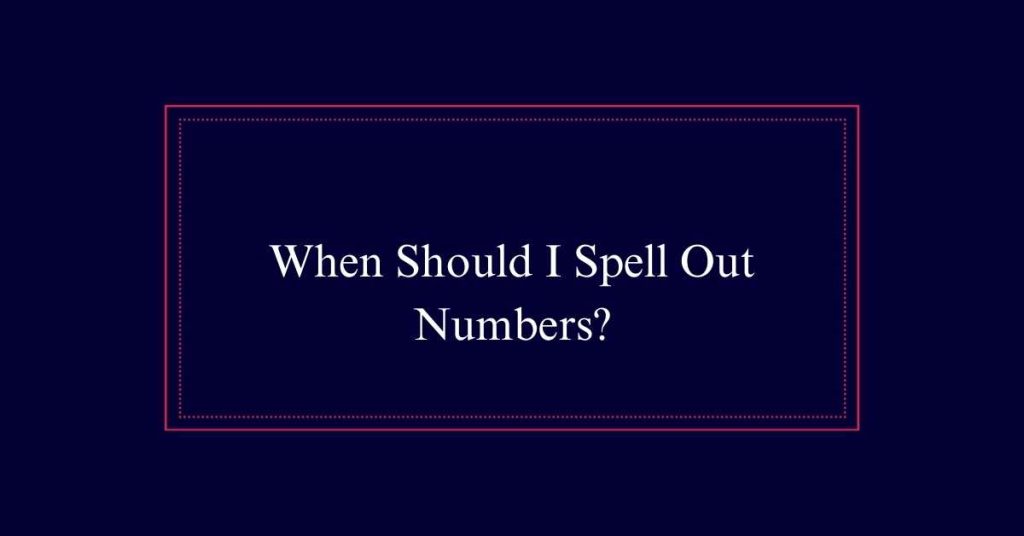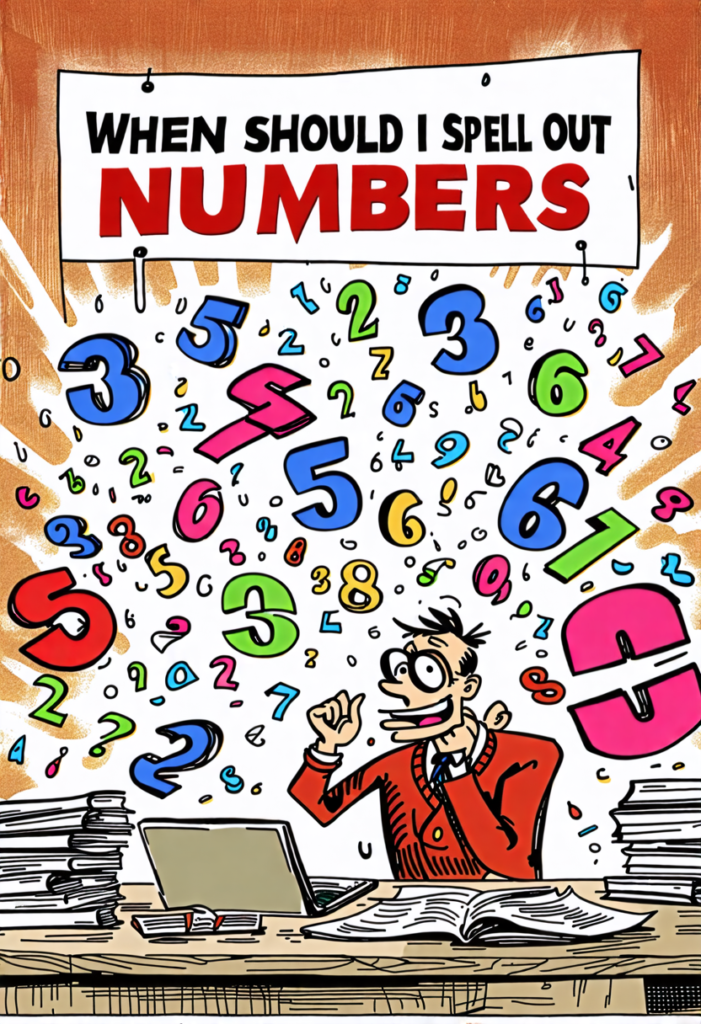When Should I Spell Out Numbers?
In professional writing, spell out numbers less than ten for consistency and readability. For example, use ‘three experiments’ rather than ‘3 experiments’. However, always use numerals for fractions, decimals, and units of measurement (e.g., ‘5 cm’ or ‘3.5 liters’), as they guarantee clarity and precision. Monetary amounts should also be presented with numerals and symbols (e.g., $10, €20).
Consistent formatting is essential for maintaining a professional tone throughout your document. When larger numbers and complex data are involved, this approach helps maintain clarity and avoid confusion.
Spelling Out Numbers in Technical Writing
In technical writing, numbers less than ten are typically spelled out to maintain consistency and readability. This practice ensures that readers can easily follow the text without being distracted by frequent numeral appearances.
For instance, phrases like ‘three experiments’ or ‘seven samples’ are easier to read than their numeric counterparts. Additionally, this rule helps maintain a uniform style throughout the document, enhancing overall clarity.
However, when dealing with larger numbers or units of measurement, numerals are preferred. This distinction helps in presenting complex data more clearly. Adhering to these guidelines is essential in technical writing to avoid confusion and make sure that the information is conveyed accurately and effectively.
Exceptions for Fractions and Decimals
Fractions and decimals often require numerals instead of spelled-out numbers for clarity and precision. In technical and scientific writing, using numerals for fractions and decimals enhances readability.
For example, writing ‘0.75’ is clearer than ‘three-quarters.’ Similarly, ‘3.14’ is more precise than ‘three point one four.’
When dealing with large numbers, it is crucial to use decimals with appropriate units. For instance, ‘1.5 million’ is preferable to ‘one and a half million.’ This approach guarantees consistency and avoids confusion.
In addition, in complex documents, such as scientific reports, numerals facilitate quick comprehension. Always use numerals for fractions and decimals to maintain precision and enhance reader understanding.
Using Numerals With Unit Abbreviations
Expressing quantities with numerals and unit abbreviations guarantees clarity and precision in technical writing. This practice is essential when dealing with measurements such as length, weight, and volume.
For example, use ‘5 cm’ instead of ‘five centimeters’ or ’10 kg’ instead of ‘ten kilograms’. This approach reduces ambiguity and enhances readability, especially in scientific contexts.
Consistency is important; always pair numerals with their respective unit abbreviations. Avoid spelling out numbers when they are followed by units. This rule applies to various fields, including engineering, medicine, and physics.
Currency Symbols and Numerals
Using numerals with unit abbreviations guarantees precision, and the same principle applies to writing monetary amounts with currency symbols. When denoting currency, always use numerals alongside the appropriate symbol, such as $10, €50, or £100. This method ensures clarity and reduces misunderstandings.
For example, ‘five dollars’ can be written as ‘$5’ for brevity. However, if mentioning money infrequently, spelling out the amount can be acceptable, such as ‘twenty dollars.’
In technical or financial documents, stick to numerals and symbols for consistency and professionalism. This standardized approach aids in maintaining clear communication, especially in contexts involving financial data or transactions.

Consistency in Style
Maintaining consistency in style when writing numbers is crucial for guaranteeing clarity and readability. Consistent number formatting helps the reader easily follow and understand the text.
For instance, if you decide to spell out numbers under ten, stick to that rule throughout your document. Avoid switching between numerals and words arbitrarily. This uniformity is especially important in technical and scientific writing, where precision is paramount.
Always use numerals for measurements, units, and currency to uphold a professional tone. Adhering to a consistent style not only aids in readability but also enhances the overall coherence of your writing.
This practice ensures that your audience can focus on the content without being distracted by inconsistent number usage.
Numbers for Readability
While maintaining consistency in style is important, guaranteeing the readability of numbers also plays a pivotal role in effective communication.
Numbers under 101 are often spelled out to enhance understanding. However, round numbers like hundreds and thousands are exceptions and can remain as numerals. This approach helps minimize confusion and keeps the text clear. For example, writing ‘fifty’ instead of ’50’ can make the text flow better.
Additionally, numbers in technical contexts, such as measurements and monetary amounts, should be presented as numerals with appropriate symbols or unit abbreviations. This ensures clarity and precision.
Starting Sentences With Numbers
Starting a sentence with a number often requires spelling out the number to enhance readability and maintain formal writing standards. This approach guarantees clarity and avoids confusion, especially in professional or academic texts. For example, writing ‘Twenty students attended the seminar’ is preferable to ’20 students attended the seminar.’
Consider the following guidelines:
- Spell out numbers: Always spell out numbers at the beginning of a sentence, regardless of their size.
- Rephrase sentences: If a large number begins a sentence, consider rephrasing the sentence to avoid starting with the number.
- Maintain consistency: Ensure the number format is consistent throughout the document to uphold readability and professional standards.
Common Spelling Errors
Properly spelling out numbers at the beginning of a sentence can also help avoid common spelling errors such as confusing ‘forty’ with ‘fourty.’ This mistake is common because many assume the pattern of ‘four’ continues in ‘forty.
Another frequent error involves ‘seventh’ and ‘seventieth,’ where writers might mix up ordinal and cardinal forms. Additionally, ‘ninety’ is often misspelled as ‘ninty,’ likely due to the influence of ‘nine.’
These errors can distract readers and reduce the credibility of your writing. To avoid such mistakes, always double-check and, if unsure, refer to a reliable dictionary. Consistent accuracy in spelling out numbers enhances clarity and maintains a professional tone in your writing.
Flexibility in Sentence Structure
Flexibility in sentence structure is essential for maintaining readability when spelling out numbers. Writers often need to restructure sentences to avoid awkward phrasing and guarantee clarity. This adaptability is important, especially when numbers start a sentence or when multiple numbers appear in close proximity.
To enhance readability, consider the following tips:
- Rephrase sentences: If a sentence starts with a number, try rephrasing it so the number appears later.
- Combine sentences: Merge shorter sentences to avoid repetition of numbers.
- Use synonyms: Replace numbers with words like ‘several’ or ‘many’ where appropriate.
Large Numbers and Readability
When dealing with large numbers, ensuring readability becomes even more important. Using numerals for large numbers helps maintain clarity. For instance, write ‘1 million’ instead of ‘one million.’ This approach prevents confusion and aids reader comprehension.
When expressing fractional quantities of large numbers, use decimals, like ‘2.5 billion.’ This method enhances precision and readability. Always accompany large numbers with appropriate units or terms, such as ‘3 billion years’ or ‘$10 million.’
Consistency in presentation is vital. Avoid switching between numerals and words within the same context. For very large numbers, scientific notation can be useful, especially in technical writing. Adapting these practices guarantees that large numbers are clear and easily understood by the audience.
Frequently Asked Questions
When Should I Spell Out Numbers in Dialogue?
In dialogue, spell out numbers under 101 and round numbers like hundreds or thousands. Start sentences with spelled-out numbers. Use numerals for clarity when necessary, but maintain consistency for readability and audience understanding.
Should I Spell Out Numbers in Titles and Headings?
Spell out numbers in titles and headings for better readability and impact. Use numerals for large, complex numbers to maintain clarity. Always prioritize consistency and consider the context to make sure your audience understands the content.
How Should I Handle Numbers in Lists or Bullet Points?
In lists or bullet points, use numerals for clarity and brevity. This guarantees quick comprehension and visual appeal. For consistency, apply the same rule throughout the list, regardless of the numbers’ size.
Are There Special Rules for Spelling Out Numbers in Legal Documents?
In legal documents, numbers one through nine are generally spelled out, while numerals are used for 10 and above. Consistency and precision are critical, especially for dates, monetary amounts, and legal references.







